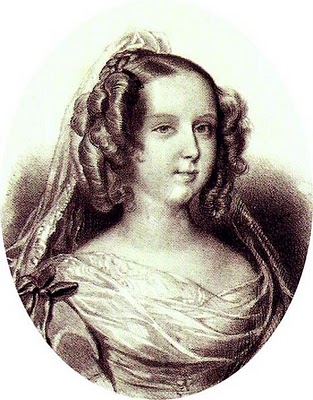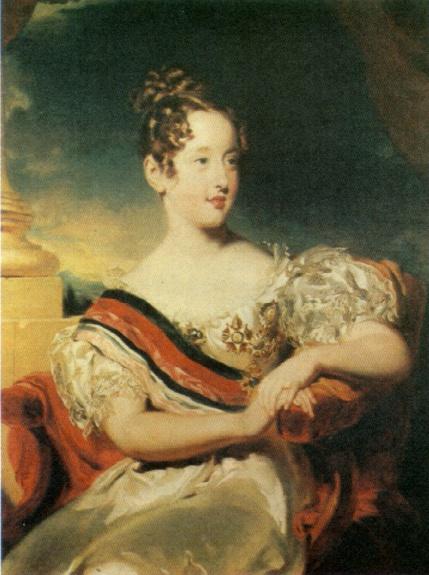<Back to Index>
- Mathematician François Édouard Anatole Lucas, 1842
- Painter John Hoppner, 1758
- Queen of Portugal Maria II, 1819
PAGE SPONSOR


Dona Maria II (Rio de Janeiro, 4 April 1819 – Lisbon, 15 November 1853) was Queen regnant of Portugal from 1826 to 1828 and later from 1834 to 1853. She was the second Queen regnant of Portugal and the Algarves, and the 29th or 30th Portuguese monarch. She was a member of the House of Braganza.
Born Maria da Glória Joana Carlota Leopoldina da Cruz Francisca Xavier de Paula Isidora Micaela Gabriela Rafaela Gonzaga, Maria da Glória was the daughter of the future King of Portugal and first Emperor of Brazil, Peter IV and his first wife Maria Leopoldina, Archduchess of Austria, herself a daughter of Emperor Francis II. Born in Rio de Janeiro, Brazil, Maria is the only European monarch to not have been born in Europe.
When Maria's grandfather King John VI died in March 1826, there was a succession crisis in Portugal. The king had a male heir, Peter, but Peter had proclaimed the independence of Brazil in 1822 and he was then Emperor Peter I of that country. The late king also had a younger son, Miguel, but he was exiled in Austria after leading a number of revolutions against his father and his liberal regime. Before his death, the king had nominated his favourite granddaughter, Isabel Maria, to serve as regent until "the legitimate heir returned to the Kingdom" — but he had failed to specify which of his sons was the legitimate heir. Peter, the liberal Emperor of Brazil, or Miguel, the absolutist exiled prince?
Most people considered Peter to be the legitimate heir, but nobody wanted him to unite Portugal and Brazil's thrones again. The European country had been under Brazilian rule when both were part of the United Kingdom of Portugal, Brazil and the Algarves, established by the King John VI during his stay in Rio de Janeiro from 1808 until 1820. Aware that his brother's supporters were ready to bring Miguel back and put him in the throne, Peter decided for a more consensual option; he abdicated the throne to his eldest daughter, Maria da Glória (who was only seven years old), and she should marry her uncle Miguel, who should accept the liberal constitution and act as a regent until his niece was an adult. Miguel pretended to accept, but when he arrived in Portugal he deposed Maria and proclaimed himself King, abrogating the liberal constitution in the process. During his reign of terror, Maria traveled to many European courts, including her grandfather's in Vienna, as well as London and Paris. Peter abdicated the Brazilian throne in 1831 in favor of his son (and Maria's younger brother, Peter II), and from his base in the Azores he attacked Miguel, forcing him to abdicate in 1834. Maria was thereupon restored to the throne, and obtained an annulment of her betrothal.
On 26 January 1835 she married, at the age of fifteen, Auguste, Duke of Leuchtenberg, son of Eugène de Beauharnais, and grandson of Empress Josephine. However, he died only two months later on 28 March 1835. On 1 January 1836 Maria married the cultured and able Prince Ferdinand of Saxe-Coburg and Gotha, who ruled with her as a co-monarch. He received the title of King in 1837, in accordance with Portuguese custom, upon the birth of their first child Peter, an heir to the throne.
In 1842, Pope Gregory XVI presented Maria with a Golden Rose.
Maria's reign saw a revolutionary insurrection on 16 May 1846, but this was crushed by royalist troops on 22 February 1847, and Portugal otherwise avoided the European upheavals of 1848. Maria's reign was also notable for a public health act aimed at curbing the spread of cholera throughout the country. She also pursued policies aimed at raising the levels of education throughout the country.
After constant pregnancies and births, doctors warned Maria of the dangers of giving birth nearly every year. However, she ignored the risks that had killed her mother, who had died of complications following a miscarriage after many births; "If I die, I die at my post", Maria said. In 1853 she died while giving birth to her eleventh child, Prince Eugene, who also died.
Maria II is remembered as a good mother and a kind person, who always acted according to her convictions in the attempt to help her country. She was later given the surname "The Good Mother."